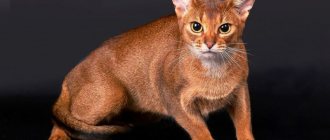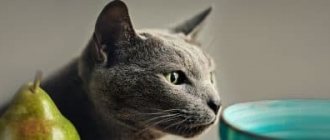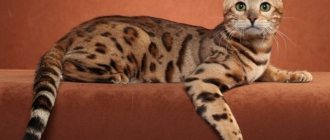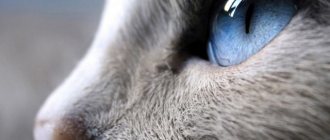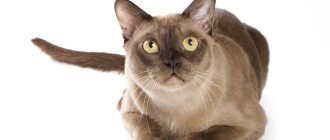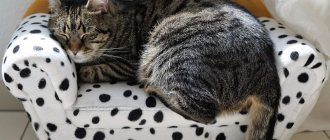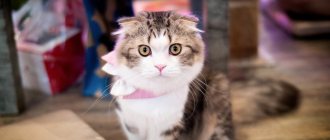History of the origin of the breed
Like many other cats, the first kittens in the breed were born spontaneously, thanks to a successful random combination of genes.
There is no exact information about this breed; it is impossible to say when and where exactly they were born. That is why the history of their appearance is shrouded in various legends, some of which contradict each other. The most common version says that they were born in the mid-19th century. British sailors brought kittens to Arkhangelsk. In appearance, they were very similar to the British, but had some differences in the structure of the shape of the skull and torso. The Russian blue cat reached a new level of its distribution thanks to a breeder from England. These animals received their first signs in 1893, when kittens were crossed with other cat breeds. These attempts did not bring success. The kittens were obtained without the characteristic plush fur, which stands out against the background of representatives of other breeds. It was decided to start breeding a purebred breed. They received their official recognition in the 30s of the last century. Felinologists and breeders began breeding with special effort after the end of World War II.
Interesting read: everything about exotic cats.
Types of cats
Types of cats artificially created by man, having fixed hereditary characteristics, are combined into breeds. The pedigree of a cat is confirmed by an official document - a “pedigree”, issued by a club that is part of one of the felinological unions. Each of these organizations has its own descriptions and criteria for breed recognition.
Siberian and Maine Coon mixed breed
According to these organizations, now in the world there are from 40 to 80 varieties of animal breeds related to domestic cats, mongrel cats and mestizos. Mestizos are the fruits of mating animals of different breeds. A mixed-breed cat and a male cat also belong to the mongrel category, but have the peculiar features of purebred animals. As an inheritance, a mestizo kitten receives the main qualities of its parents: health, endurance, intelligence.
Purebred toyger - mini tiger cat
External features and standard
Description of the Russian Blue cat breed is characterized by the following requirements:
- the skull has a pronounced chin, flat forehead, straight nose;
- flat, high-set cheekbones;
- pronounced whisker pads;
- wedge-shaped muzzle;
- large ears with sharp tips and a wide base;
- large almond-shaped green eyes;
- short, silky soft coat;
- uniform blue color with a silver tint at the ends of the hairs;
- medium-sized body with pronounced muscularity;
- Long neck;
- long slender legs.
This cat breed takes part in all exhibitions, international competitions and other felinological events. The size and weight of the Russian Blue cat is average for cats. Body weight can be 3.5-5 kg.
Question to the expert
How long do Russian blue cats live?
The life expectancy of representatives of this breed depends on the individual characteristics of the animal, living conditions, care and feeding. But on average, Russian Blue cats live about 20 years.
The eyes of the Russian Blue cat are emerald green.
Breed varieties
The Russian Blue cat has several types of breed, each of which has its own standards. These cats are divided by breeding geography as follows:
- North American Russian Blue cat, recognized in the TIKA and CFA felinological systems. It is distinguished by a more oriental appearance, an animal with a wedge-shaped skull, unfolded ears, and double coat.
- European or WCF - the pet has a flat skull, thick fur, colored a uniform blue with a characteristic silver tint.
- English standard (recognized by the GCCF). These cats have a wedge-shaped, shortened head. The coat is light blue, thick and dense.
- Scandinavian type, close to the standards of the North American cat.
Chart of characteristics of the 4 types of Russian Blue cats.
Sometimes the Russian Blue cat changes color. The silvery tint of the coat can change under the influence of external factors: excess heat, frequent exposure to direct sunlight, oversaturation of the diet with copper and iron.
Kittens may have rings on their tails that disappear as they grow older. This is not considered a disadvantage. In addition to the Russian Blue, there are also Russian White and Russian Black cats. They are less common than their silver-blue counterparts.
Eyes of a Russian Blue cat.
Differences between Russian Blue and British Blue
The only thing that the Russian Blue and British breeds can have in common is their color. An inexperienced person may confuse them, especially if they are dealing with a small kitten. There are several significant differences between these breeds:
- Eyes. The Russian Blue cat is distinguished by an unusual shade of green eyes, reminiscent of emerald. The British eyes are copper or yellow.
- Wool. The Russian Blue cat is soft to the touch, fluffy, and the hairs lie tightly to the body. The British fur coat is more like plush.
- Body. The British have a more massive, dense body. In the Russian breed it is rather fragile, elegant, and graceful.
You can easily distinguish cats of these breeds by the shape of their skull. In the British, it has a rounded shape, a muzzle with pronounced thick cheeks. The head of the Russian Blue cat is more reminiscent of the standard cat shape, with a pointed muzzle.
Material on the topic: popular colors of the Scottish cat breed.
Russian blue cat
These amazingly beautiful silver-blue cats are well known all over the world. Meanwhile, there is still no consensus about their origin. They say that the first cats of this breed were brought to England from Arkhangelsk by British sailors. But where they came from in Russia is unclear. It must be said that short-haired cats of a similar color were already known in Europe and initially the Russian Blue was not distinguished from them, calling them either Maltese or Spanish. For a long time she was presented at exhibitions in the same class as the British Blue. And only by the end of the 30s of the twentieth century the final name Russian Blue was assigned to it. Then it was allocated to a separate class. After World War II, Russian Blues practically disappeared. And then breeders began to restore the breed. To do this, they infused Russian Blues with blood from the British and Siamese breeds. Crossing with British cats did not give good results - all the resulting specimens were very heavy. And when crossed with Siamese cats, the descendants received lighter bones and a straight nose. But at the same time, the cats’ fur became shorter and, unfortunately, the undercoat disappeared.
In the end, after long and painstaking work, the breeders managed to restore the appearance of the Russian Blue cat. The standard was written again, and Russian Blues again shone at exhibitions. From time to time, kittens with long hair appeared in the litters of these cats. Such animals were discarded - the breeders did not want to allow them into further breeding. However, several long-haired Russian Blue kittens were lucky enough to be born into one American family. The owner of the kittens, Cora Cob, noticed the unusual fur of the babies and did not fail to contact geneticists. But geneticists are scientists - they knew that among Russian Blues there are long-haired versions of cats. And they said, “these are long-haired Russian Blues.” And from that moment on, Cora Cob began to deal with long-haired Russian blue cats. Cora named the new breed Nibelungs. In fact, Nibelungs are the same Russian blues, only with long hair. Today, both are known in the world, and a standard has been written for both. Exterior.
The Russian Blue is a medium to large sized cat with a short, thick and velvety coat. Her body is long, flexible and graceful. The limbs are elongated, with small oval or rounded paws. The hind legs are slightly longer than the front. The tail is long, thick at the base, tapering to the tip. The neck is long and thin, although the thick fur makes it look short. The head is wedge-shaped, the nose is straight, the forehead protrudes above the nose. The skull is flat and narrow, the chin is strong. The ears are quite large, wide at the base, pointed at the tips, and set straight. The eyes are almond-shaped, set wide apart, slightly angled in relation to the nose. According to connoisseurs of the breed, the Russian Blue has two main advantages: eyes and a silky coat. The eyes of these purrs are green, like grass, large, almost round, they attract attention and undoubtedly cause admiration. The eyes of the Russian Blue sometimes take on a tragic expression, which, combined with an apparent half-smile, gives these cats a mysterious appearance. Cats can have eyes of varying shades of green, from soft lime green to dark bottle green. Moreover, when a kitten is born, its eye color is blue and gradually changes with age. You can confidently talk about the color of a cat’s eyes only after she is a year and a half old, or even more. But you can’t go wrong with the color of the coat: everything is clear from the name of the breed. True, if previously cats with a darker tint of fur were in fashion, now, on the contrary, light blue cats are increasingly popular. There should be no spots, patterns, or stripes in the color. The exceptions are transverse stripes on the tail - they occur in kittens and young animals. The blue color is found in a number of breeds, but only the Russian Blue has such a light shade and a pronounced silver tint. This happens because the tips of the guard hairs are discolored and in the light they appear silvery - the brighter it is, the better. The Russian Blue fur coat itself is unique: soft, silky to the touch, it has a double texture, thanks to which it is famous throughout the world. Double texture means that a cat's fur consists of two types of fibers: hair and fluff. Moreover, a Russian Blue cat must have a lot of fluff in order for the fur to be dense. The term double coat also implies that the down and hair must be the same length. Thanks to this, the fur does not adhere to the body: it is short, it resembles the fur of a fur seal. The Russian Blue is a slender, flexible, graceful cat. Her movements are characterized by smooth fluidity and resemble the light step of a ballerina. It is characterized by graphic purity of body lines. Cats, as a rule, are medium in size, and males are quite large, their weight reaches 4-5 kg. Character.
Russian Blues are very cautious cats who know their worth; they are jealous of their territory and wary of strangers. If you paid a visit to your friends and a Russian Blue came into your arms, then congratulations - this is real luck! Usually the Russian Blue takes up some kind of observation position and watches you from afar. And no matter how much you want it, he will not communicate with you until he recognizes you as one of his own. Russian blue cats are very cautious, and sometimes they can even get scared and hide from you somewhere in a secluded place. In general, it is impossible to say that a Russian Blue will rush at the first call. Unless, of course, it’s the owner’s call. They will play with strangers, but first they need to get used to this person: they sniff, walk around. And if this person inspires their trust, then the Russian Blue will play with him. As soon as you gain confidence in the blue beauty, you will have a devoted friend at your disposal: cheerful, affectionate, playful. There is especially no doubt about the latter: very agile and agile, Russian Blues amaze with their jumping ability. What can they do in a jump! And catching prey lying high up is also not a problem. In general, the hunting instinct of the Russian Blue is very well developed. No wonder she was considered the best rat catcher among the sailors. And today, various toys, mice - everything becomes an object of hunting. Like all cats, Russian Blues choose their owner from among family members. However, this does not mean that she will show disrespect or aggression towards others - far from it. These cats love both children and animals. They can easily get along with a rat, a rabbit, and a guinea pig. Another thing is that the pig is scared to death of this fluffy beauty. Breeders and owners of blue cats have noticed one peculiarity: these cats have a very strange attitude towards water. When you turn on the water, the cat immediately runs to the tap and touches the water with its paw, licks it with its tongue, and crawls under the stream with its ears. For all their oddities in public, Russian Blues behave with restraint and confidence, which is what wins the hearts of their owners. Care.
Keeping a cat in the house is a big responsibility. And although the Russian Blue is unpretentious, owners should still know some features of caring for it. The fur of these cats is amazing: not only does it require minimal care from you, but it also practically does not cause allergies. Such plush fur does not need to be combed - just go through it with a special comb during shedding periods and your cat is in perfect order. And if it sheds too much, then after combing it, you can wipe it with a wet hand. Well, perhaps the most pleasant thing: if you have wanted to have a cat all your life, but did not do it, fearing that a characteristic smell would settle in the house, take a Russian Blue cat. This breed does not mark territory. To bathe or not to bathe a Russian Blue - each owner decides for himself. But before the exhibition, it’s definitely worth washing your child. During the molting period, you can also make the animal’s existence easier by bathing it. But in principle, the cat is able to cope with this problem on its own. Just don’t forget to feed your cat green grass or buy oats for cats at the store. This will help clear the stomach of accumulated hair when licking. The problem of feeding disappears by itself if you choose dry professional food. True, if you are not indifferent to what shade of your beauty’s fur, we advise you to study this issue in more detail. Which food should I choose for my Russian Blue cat? If you give a certain type of food, cats turn brown and darken. Consultations with a veterinarian and breeders will be helpful. Well, and more. When choosing between dry food and, for example, canned food for cats, keep in mind that the optimal ratio in a cat’s diet is 3:1 - 75% dry food and 25% canned food. And no more additives are required.
Pet character and temperament
The Russian Blue breed is a type of cat with which there are no difficulties or problems.
Whims, excessive self-indulgence, malicious sabotage - all this is not about them. Instead, these cats have innate intelligence, sensitivity, and compliance with the established rules of behavior accepted in the given territory. They are loyal to children's pranks with them, while understanding that they are dealing with a child and do not let out their claws. However, it is still not worth leaving them alone. They get along with other animals if the former do not show aggression, arrogance or provocation. Any place for these cats is the top shelves of cabinets, at a height of at least 1.5 meters from the floor. They perceive affection from a person very well, but they will not allow themselves to be squeezed. In their souls they still have the instincts of an independent predatory animal.
Getting a mouse, a pet hamster or a parrot is a matter of principle. The character of the Russian Blue cat has a certain peculiarity - the need to hunt in a playful way. In a city apartment, the object of hunting will be flies, small insects or imaginary objects of hunting. While chasing them, cats often lose their vigilance, which often leads to them falling out of windows, which can cause serious injury or even death.
Maintenance and care
The Russian Blue is a short-haired cat breed, but caring for them is complicated by the presence of a very thick, dense undercoat. Brushing should be done at least twice a week. It is advisable to use a furminator for this. Particular attention must be paid to the cat during the molting period. The kittens themselves are clean and can be washed no more than once every six months. Every two weeks it is necessary to clean the animal’s ears and eyes by wiping them with a moistened cotton pad. These cats are demanding about the cleanliness of their dishes. Their water or food bowls should always be kept perfectly clean. A kitten or cat should have the opportunity to express its energy. To do this, you can purchase a house that is better located at a height. Otherwise, he will climb on shelves or cabinets.
Russian white cat.
How to choose the right food
You can feed your Russian Blue cat with prepared or natural food. The pet must receive premium, super-premium or holistic food. The composition of these feeds is balanced in composition, containing a sufficient amount of all substances necessary for the body, as well as the optimal amount of proteins, fats, and carbohydrates. Natural nutrition should contain:
- non-fatty meats, ideally rabbit, turkey or veal;
- meat by-products;
- boiled egg yolk;
- boiled varieties of sea fish;
- kefir, cottage cheese, other low-fat fermented milk products;
- boiled or raw vegetables;
- cereals
You should not give your pet smoked, fried, food with salt and spices.
Health and illness
The average lifespan of a Russian Blue cat is on average 15 – 20 years. These kittens have good heredity and do not have any serious genetic diseases. However, they are prone to problems with the respiratory tract and digestive system. Such a phenomenon as food allergies is not uncommon for them. As you age and your metabolism slows, you may experience weight gain. In this case, you should limit your caloric intake.
Vaccinations and antiparasitic treatment
The first vaccinations are given at about two months of age. Typically, complex drugs are used for this purpose, causing stable immunity to:
- rhinotracheitis;
- calcivirus;
- rabies;
- herpes virus infection;
- panleukopenia.
After 4-5 weeks, kittens must be revaccinated, but with the addition of anti-rabies components. After this, vaccinations are given once a year. Vaccinations are mandatory and recommended.
A week before vaccination, the pet should receive antihelminthic medications. They are given once every three months. Adults once every six months, repeating the procedure after two weeks. As soon as the animal shows the first suspicious symptoms, you should immediately contact a veterinarian. You should not self-medicate or look for answers to questions on the Internet.
Sterilization and castration
If the animal lives in a city apartment and is not planned for breeding, it is better to sterilize it. This operation is performed over a period of 7-10 months. Castration and sterilization should not be confused - these are essentially different operations. Castration is the removal of the gonads from an animal, and sterilization is the tying of the spermatic cords in males or the fusion of the oviducts in females.
Adult blue cat.
Chartreuse Health
The health of the breed is at a high level. Only closer to old age can cats begin to develop joint problems. Young cats very rarely suffer from feline diseases, especially with timely vaccinations according to the vaccination schedule, and regular deworming.
global $ads_google; //data-ad-slot=”2475549904″ $ads_google = empty($ads_google) ? false : true; ?> if ($ads_google == false) {?> $ads_google = true; ?> } ?>
The gray cat with amber eyes has two weaknesses: teeth and a tendency to obesity. Both problems can be successfully solved with care and care.
Cute blue-gray Chartreuse live for about 13 years.
Kittens are often sold after sterilization. If you have to castrate a cat, then this is done after 6-8 months. This is due to the conditions for breeding purebred cats: crossing is allowed only within the breed, and in addition, there are no officially registered Carthusian breeders in the Russian Federation.
How to choose a kitten
Shorthair Russian Blue cats are bred in many catteries; a sufficient number of breeders are engaged in them. Finding a suitable individual will not be difficult. When choosing a baby, it is recommended to pay attention to eye color. They should be emerald green in color. You should not take kittens with yellow irises, even if the breeder assures that they will turn green over time. The kitten's coat should have so-called silvering.
If there are inclusions of other colors, one should doubt the purity of its pedigree. The presence of stripes or tabbies is not a defect that will disappear with adulthood. The kitten must have clean eyes and ears. If a kitten runs away when new people appear, such individuals cannot be chosen either. A good reliable nursery will not sell its animals before three months. When choosing a nursery, it is important that it is registered with felinological organizations and has all the necessary documents.
How much do Russian Blue kittens cost?
Getting purebred kittens that can take part in exhibitions and breeding is a very difficult and expensive task. The average price for such kittens is 23,000-28,000 rubles. A kitten with an ideal pedigree can cost about 40,000. If we talk about individuals that are offered through advertisements on sales sites at a price of 3000-5000 rubles, most likely such kittens do not have any supporting documents, or they appeared as a result of an unplanned mating.
How to name a kitten
When choosing a nickname for your pet, it is important to take into account the nature of this breed. Its representatives are obedient, intelligent, affectionate, and are not inclined to mischief. At the same time, they have a certain touch of aristocracy and even elitism. The pet's name should suit all these characteristics. The table below shows popular names for cats.
Table of popular names for cats and cats.
Unique and unpredictable mestizos
Metis is the result of crossing cats of different breeds. Or outbreds. In general, any cats without a pedigree are called mestizos. They inherit the best qualities of their parents: endurance, intelligence, health. Among the mestizos, no two cats are alike. Each of them has a unique appearance. What purebred representatives of cat breeds cannot boast of.
Metis are the most common cat breed on earth.
Mestizos are very diverse. It is possible to predict the temperament and appearance of a cat only if it was born in a nursery or at home and the parents are known. The kitten inherits behavioral patterns from its father and mother. The character of mestizos depends on their upbringing and habitat. Life experience is what shapes the personality of a half-breed. If a mixed breed of an elite breed is raised and nurtured as an aristocrat, he will exhibit traits inherent in the breed. And when a cat has to fight for his life, all manifestations of character will be aimed at survival.
The history of cohabitation between humans and cats goes back more than 10 thousand years. In ancient times, cats were not distinguished into separate breeds. Depending on the region of residence, climate, and nutrition, they had different appearance and character traits. Later, with the development of navigation, it became possible to mate cats from different regions. Then the first mestizos appeared.
Felinologists were divided into two camps. Some breeders do not recognize mestizos as full-fledged cats and mercilessly cull them. Others, on the contrary, consider mixed cats smarter, more educated, more resilient than purebred cats and endowed with properties unattainable for aristocrats.
Mixed breeds do not meet breed standards, so they are not sold. Or they charge a symbolic price. A gifted kitten is believed to bring good luck.


